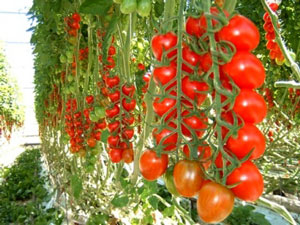 Proper preparation of a carbonate greenhouse
Proper preparation of a carbonate greenhouse
When, a gardener or a summer resident installs a polycarbonate greenhouse on his plot, then the amount of preparatory work will be significantly reduced if a similar comparison is made with greenhouses or similar structures. It is also necessary to execute greenhouse processing, wipe all the walls and correctly install the ventilation system.
Compared with the film-based design, this greenhouse is perfect for the quick and easy process of growing tomatoes. In film greenhouses and hotbeds, there is a noticeable temperature difference, especially in the daytime and nighttime. Therefore, such greenhouses should be insulated and at the same time between the layers, leave an empty space of 1.5-3 cm. Thus, it is possible to protect the structure from sudden cold snap. People are interested in growing tomatoes in a polycarbonate greenhouse.
In a situation where ventilation systems are not installed in the greenhouse, then they need to be done urgently. Since a high yield and ripening efficiency depends on well-established ventilation. Tomatoes need constant and high-quality ventilation of the room. Optimal and simple option: create window leaves on the roof and side parts of the greenhouse. Even the simplest ventilation system will increase the level of productivity and the efficiency of germination of tomatoes.
Selection of planting material or soil
Polycarbonate-based greenhouses, like other similar constructions for the effective cultivation of tomatoes, require a competent choice of soil or planting material. The higher the level of soil fertility, the better the plant will germinate and produce fruit.
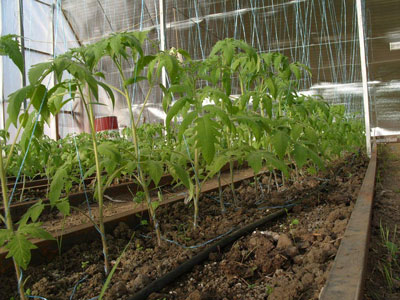
Greenhouse soil is prepared by removing the upper layers up to 10 cm. Basically, it is precisely this depth that suggests the location of pests and fungal spores that can harm tomatoes. The next step is disinfection of the soil. To perform this procedure, you must use copper sulfate. A tablespoon of vitriol is used on a bucket of water. If you look at photographs and video instructions at various horticultural forums, then the fact that for efficient flowering and ripening of fruits, the use of fertilizing and fertilizing is necessary stands out against a special background. Interesting to consider growing tomatoes in a polycarbonate greenhouse in the video.
In a situation where clay and loamy soil is observed, it is necessary to use wood-based sawdust and peat. In some cases, humus can be used, but not necessarily. These components are able to organize the looseness of the soil, and the roots can "breathe" and get enough air.
As a rule, peat is heavier with turf or sawdust. Coarse sand should also be added in small quantities. In its pure form, chernozem is also diluted with humus or sand. In addition to these additives, it is necessary to feed the soil. For this, fertilizers are used on nitrate, superphosphate and wood ash.
The optimal time period for planting seedlings
For seedlings, you must use healthy and large seeds. In addition, the planting of tomato seedlings in a polycarbonate greenhouse is carried out in late February or early March. Gardeners want to know how to grow tomatoes in a polycarbonate greenhouse in the suburbs.
For proper germination, seedlings should be about 24 cm, with a period of not more than 2 months. Such parameters are indicated for tomato seedlings in greenhouse growing conditions. Do not rush, because you can damage the roots of seedlings.In addition, the plant should be planted relatively vertically and cover it with soil to the first leaves. After the plant begins to germinate, the hole is filled with soil and the first watering of tomatoes begins.
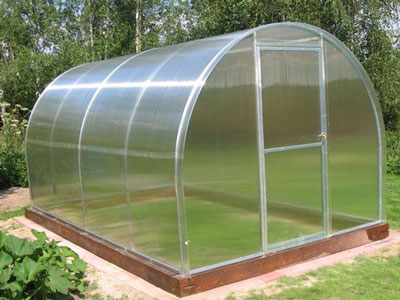
It is very important to observe competent watering of the plant, as well as monitor the adaptation of precocious tomatoes. The distance between the tomatoes should be at least 50 cm. Because planting too close will lead to a decrease and loss of yield. Root systems will interfere with each other, and the plant will not be able to "breathe".
Basic rules for the care of tomatoes:
1) Abundant watering.
2) Loosening the soil.
3) Fertilizer fertilizer.
4) Effective protection against various pests.
5) Timely garter.
6) Regular weeding.
Even if at least one of the indicated points is not met, the risk of yield loss will increase significantly. The competent organization of a drip irrigation system in a carbonate greenhouse will favorably affect tomatoes and high productivity. For mulch, straw should be used. This will help in the further process of loosening and weeding. Proper cultivation of tomatoes in a polycarbonate greenhouse: Ganichkina and other varieties.
Tomato varieties for carbonate greenhouses
When deciding on the choice of tomatoes, it is necessary to take into account factors such as fruit ripening, appearance, yield, high resistance to pests, and plant height. Polycarbonate greenhouses suggest growing tall varieties of tomatoes. Therefore, they should be regularly tied up and nipped. Indeterminate tomatoes are able to reach maximum heights. If we talk about the most popular varieties of tomato, then it should be highlighted: “King of the giants”, “Khokhloma”, “Miracle of the earth” and others. How to grow and grow tomatoes in a polycarbonate greenhouse in Siberia.
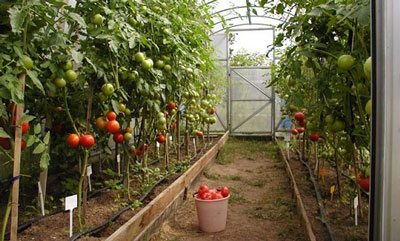
Similar varieties of tomatoes are capable of producing a large crop over a long period of fruiting. If we are talking about earlier varieties, then breeding varieties are distinguished: "Typhoon", "Search" and others. Gardeners and gardeners prefer to use tomatoes in size. Therefore, if we talk about large root crops, then such varieties as "Eagle's Heart", "Cardinal" stand out. Tomatoes of medium size: "Kindergarten", "Lamp". As winter preparations, such varieties as "Empire" and "Cherry" are suitable.
Proper planting and seed selection
Planting material should be selected based on their common characteristics and productive qualities. Before sowing, it is necessary to soak the seeds with a manganese solution for several days. The optimal period for planting seedlings, late February - early March. In addition, the soil for sowing and further transplantation should be identical in composition. Thus, the culture adapts much better to the new conditions of germination. Effective tomato growing in a polycarbonate greenhouse in winter: video review.
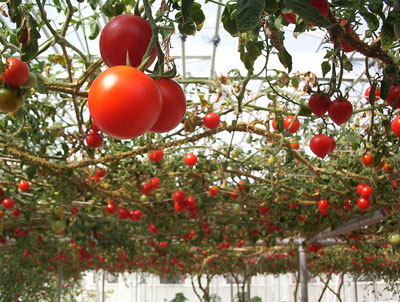
The first shoots are abundantly watered with thermal water for a week. At a later stage, watering should be done when absolutely necessary. As soon as the first leaves appear, seedlings must be transplanted. Also, young seedlings must be fertilized after a 2-week transplant. As a top dressing, nitrophos is best used. Upon reaching the optimum plant height of up to 30 cm, it should be transplanted into the greenhouse. Do not forget about the preliminary preparation of the soil for planting tomato seedlings. Tomato "Eupator" gives a high yield of fruits.
Video review of how the cultivation of tomatoes in a greenhouse
First of all, the topsoil is removed and soil disinfection is performed.As mentioned earlier, in a 10 liter bucket of water, copper sulfate is bred in the ratio of 1 tablespoon. After this, peat, humus and wood-based sawdust are added to the soil mixture. The proportion is 2/1/1. About 1 week before transplanting to the greenhouse, it is necessary to perform soil treatment with the biological composition of the active substances and preparations. Effective cultivation of tomatoes in a polycarbonate greenhouse, as a business.
It is advisable to use natural preparations without hazardous chemicals. This process will reduce the likelihood of pests and fungi. Planting seedlings is performed in pre-prepared wells. The total size of one hole should not exceed 25 cm². The distance from one plant to another should not be less than 10 cm.
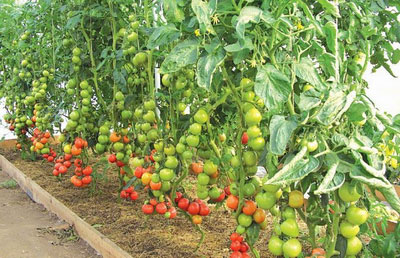
Since the bushes should not create a shadow and "strangle" each other. In the case of planting undersized tomatoes, you must use the rules of the chessboard. The distance of the tomatoes in this case should not be less than 30 cm, since each bush forms several shoots.
In a situation with tall bushes, tomatoes are planted at a certain distance, at least 65 cm. The bottom of the seat should be moistened a little and only then should the process be carried out. At the end of planting, seedlings are sprinkled with earth. Abundant watering is carried out in the first 2 weeks. Unique tomato growing in a polycarbonate greenhouse in winter.
Competent care for tomatoes
The basic rules of care are abundant watering of the plant at a certain stage of ripening, competent strapping, fertilizing with fertilizers. Until flowering, the bushes should be watered 1 time per week. Uniform watering under the root of the plant. In addition, excessive soil moisture must not be allowed, as this will lead to a possible rotting process.
Watering should be performed in the evening, and 2 weeks after transplanting, the plant is obligated. In addition, do not forget about pinching the plant at the moment when it begins to receive sufficient mass. Similar work is done in the early morning. The lateral shoots of the plant are eliminated constantly.
Tomatoes are fed at the time of the growing season. Fertilizers are made during the formation of ovaries. Cow dung, potassium nitrate, and urea should also be used. These fertilizers help the abundant growth of bushes and the effective ripening of fruits. Foliar top dressing is carried out after sunset. Morning dew favorably affects the assimilation of the applied dressing.
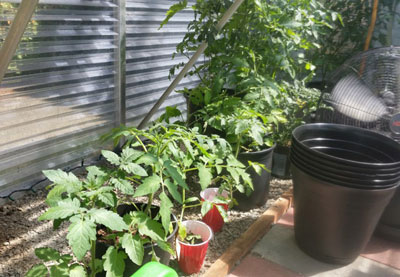
To increase the number of ovaries, it is necessary to spray tomatoes with boric acid. When, tomatoes are grown in a closed type of soil, then it is necessary to monitor the temperature level. After sunset, the temperature should be at least 15ºC, and in the daytime up to 27ºC. Flower pollination of tomatoes is carried out independently, since insects do not have direct access to plants. Especially in the situation when the bushes sprout in polycarbonate greenhouses. During the pollination period of the plant, it is necessary to brush off the bushes, slightly water and spray the stems and leaves.
Recommended:Polycarbonate greenhouse tomatoes
After performing this procedure, the greenhouse should be slightly ventilated to prevent a high level of humidity in the soil and air. Also, do not forget about constant ventilation. For this, additional air vents are created on the roof and side parts of the greenhouse. Moreover, this process should be performed only during the flowering period of tomatoes. If the future fruits begin to fall off the tomatoes, then this indicates a low level of humidity in the greenhouse. This problem is eliminated by airing and heavy watering.
To prevent the appearance of diseases and pests, it is necessary to carry out special measures for the agrotechnical care of tomatoes. Basically, tomatoes are susceptible to late blight, rotting fruits and a black leg.For effective control, it is necessary to carry out disinfection of the upper layers of the soil and apply various funds on a fungicidal basis for spraying plants.
A high level of lighting and sufficient humidity in a carbonate greenhouse, fertilizing with various fertilizers and constant care will lead to timely and effective productivity. The main thing is to follow the recommendations for competent care of tomatoes and then the process of growing tomatoes in a polycarbonate greenhouse all year round will become quite real.




 Low-growing tomatoes, without pinching: 5 of the most delicious varieties
Low-growing tomatoes, without pinching: 5 of the most delicious varieties Why tomato seedlings grow poorly
Why tomato seedlings grow poorly We grow a tomato in a shell
We grow a tomato in a shell Growing tomatoes without watering according to the method of Kazarin
Growing tomatoes without watering according to the method of Kazarin